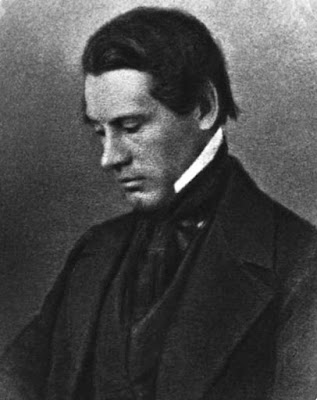Jane never attended the Pierce's school but did spend time visiting her great Aunts and Uncle John Pierce Brace in Litchfield, Connecticut. Uncle John who taught botany to the Litchfield girls must have had quite an influence as Jane became a life-long botanizer.
In her early 20s Jane found Bostonians "lecture mad" and joined in, attending a talk on botany in 1842 at the Lowell Institute by Asa Gray, a new professor of Natural History at Harvard. They shared a love of science and cataloguing and after a 5-year courtship became engaged.
"I suppose she would not be called handsome, but she has a face beaming with good temper and full of intelligence... Possesses all the usual accomplishments of persons in her station, but is most remarkable for a well-cultivated mind, and for her excellent practical powers." Asa Gray on his affianced.
Jane wrote to her Litchfield Aunt Mary about Asa. Jane didn't think he was that good looking either but, "He is quite distinguished as a botanist; & is held in very high esteem by all his friends & acquaintances."
They married in May, 1848 and Jane became partner to one of the world's leading botanists. Without children she served as his librarian, fundraiser and housekeeper of the Harvard Botanic Garden in which they lived. Cambridge became the American center of botanizing.
In June, 1861, Benjamin Brown French and his brother "walked all about the town after tea and viewed the magnificent residences. Cambridge is a lovely place."
At the beginning of the Civil War Jane invited 16 young ladies over to meet Asa's visiting niece 17-year-old Julia Bragg and to sew clothing, medical supplies and bedding for soldiers. The Cambridge girls vowed to meet weekly during the War. Read a post on the Banks Brigade soldiers' aid society (later The Bee) at this post:
http://civilwarquilts.blogspot.com/2022/04/the-banks-brigade-of-cambridge.html
The Grays' books became standard text books for teaching botany in the 1850s. Although she is rarely given unseemly credit, Jane did acknowledge writing portions and certainly acting as his administrative assistant.
"For 40 years he has planted the seeds and borne almost single-handed the burden of the botanical harvest. It would be difficult to point to any other scientific man, with the single exception of Charles Darwin, who has in his own department of learning so entirely impressed himself upon the intellectual growth of a nation."





















1 comment:
Jane Loring Gray, as you noted, was probably denied credit she deserved in her husband's illustrious career. Asa did get a US stamp in 2011: https://news.harvard.edu/gazette/story/2011/06/gray-gets-stamp-of-approval/ .
Post a Comment